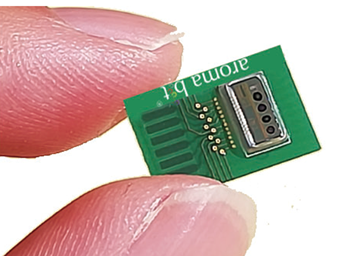
ここからコンテンツです。

Changing the world through the digitization of odors using a high-resolution odor sensor
Shunichiro Kuroki
Humans basically observe the world through their five senses of vision, hearing, touch, taste, and smell. When a human's sensory receptors encounter physical stimuli, an electrical signal is sent to the brain, stimulating recognition, judgment, or action. Since this information processing process is highly compatible with digital technology, electronic devices have been used to digitize the five senses. However, it has been especially difficult to develop devices mimicking the sense of smell, which is particularly complicated and subjective. Against this context, the development of a next-generation silicon CMOS sensor by Aroma Bit, Inc. and Toyohashi University of Technology has been a game changer. Aroma Bit Silicon Sensor Technology, Inc. was established with the goal of finding applications for the sensor in society. We interviewed the company's representative director & CEO, Mr. Shunichiro Kuroki.
Interviews and report by Akiko Seki
High-resolution odor sensor developed through industry-academia open innovation.
Mr. Kuroki explained that the next-generation silicon CMOS type odor sensor developed by Aroma Bit, Inc. and Toyohashi University of Technology is a sensor that digitizes odors, transforming them intohigh-resolution visual representations.
The sensor is comprised of a odor receptor film developed by Aroma Bit, which absorbs and desorbs an odor molecules, and the sensor element, which detects the absorption or desorption of the molecules. The sensor element originally used a quartz oscillator. However, by applying the base technology of the ultra-high-sensitivity silicon CMOS ion imaging sensor developed by the research group led by Professor Kazuaki Sawada of Toyohashi University of Technology, a more compact, lower cost odor sensor with a greater odor resolution was realized.
To accelerate the commercialization of this next-generation odor sensor, Aroma Bit Silicon Sensor Technology, Inc. (hereinafter, "ABSST") was established as a subsidiary of Aroma Bit in 2019. Mr. Kuroki is both its representative director and CEO. They decided to establish a subsidiary for commercialization because the sensor was created by a consortium launched by Toyohashi University of Technology, Toyohashi Sensor Council (TSCo), Hamamatsu Photonics K.K., Toho Technology Corp., Nippon Chemi-Con Corporation, and Aroma Bit in 2017, and they wanted to be able to promote business smoothly while maintaining their relationships.

"This is not just a success for industry-academia open innovation , but a rare case in Japan where innovation was driven by a new venture company. The success of this project was due to the fact that Professor Sawada understood and was willing to commercialize the technology, and we were able to build a good relationship with him," recalls Mr. Kuroki.
ABSST, which started as a good example of industry-academia cooperation, became the first certified venture company originating from Toyohashi University of Technology. "Being able to demonstrate that the product is based on university research is a great advantage in terms of credibility and name recognition of the technology from customers and investors," he says.
More possibilities through the establishment of an digital odor database
The mechanism the sensor uses to create visual representations of odor is almost identical to the smell mechanism of animals. When odor molecules reach the sensor, they attach to and detach from the odor receptor films. There are currently 35 types of membranes, each with different physical properties that allow them to respond to a wide variety of odor molecules.
"It is said that humans have approximately 400 types of olfactory receptors, and dogs have approximately 1200. The more receptors one has, the more molecules can be identified. The aroma bit manages to pack the same number of receptors as a dog into a 1 mm2 sensor."
When molecules are absorbed or desorbed to the odor receptor film, the electric properties of the film change. The system visualizes the odor by detecting the response as an image pattern. By teaching AI is recognise patterns, it will be able to identify a wide variety of smells. This is the same process by which living things learn to smell from experience.
"As the number of patterns the AI can recognizes increases, it will gradually become possible to identify the characteristic patterns of a certain odor in the same way that humans do. Once this becomes possible, it will also be possible to create the specific odor of a material from different materials that have the same odor pattern." For example, the ability to reproduce a specific odor without the need to use a rare living animal or plant by using a different material that emits that odor will improve the sustainability of our utilization of materials.
"In addition to the high performance of the sensor itself, which can detect a wide range of odors, the development and utilization of a database of odor patterns will start to multiply the possibilites for application. This is the big difference between conventional single-material detection devices such as gas sensors and our odor smell sensor," Mr. Kuroki emphasized.
Aiming to be the world leader in odor digitization.
The technology is drawing significant interest from the business world. Aroma Bit’s odor measurement device and the analysis technology are already being used by Meiji Corporation and the West Japan Railway Company.
In addition, the sensor is also expected to greatly aid abnormality detection systems that detect small amounts of burnt or abnormal odors before a human is able to perceive them, and for the quality control and product development of foods and commodities. Because it is able to display the elements of odor as objective data and transmit this data digitally via a network, it is also possible to identify odor in remote locations.
Mr. Kuroki has identified healthcare as one of the areas where AromaBit can be used in the future. It has the potential to detect periodontal disease and various other diseases by smell. It is also expected to be useful in abnormal detection systems that can detect the slightest trace of smoke or other targeted odours at a level below humans can detect. This capacity may also be useful in quality control and product development for food and daily necessities. Since it is able to display the elements of odor as objective data and transmit this data digitally via a network, it is also possible to identify odors remotely.
After graduating from a university in the U.S., Mr. Kuroki worked as a semiconductor engineer and then an investment analyst in high-tech fields for a foreign-affiliated investment bank, and then worked at an intellectual property fund before starting his own business. He said that the particular challenge of marketing odor sensors derives from the fact that the digitization of this field is relatively poorly developed. "The odor sensor is a new technology without a pre-existing market. Therefore, the challenge is that we have to develop the technology and create the market at the same time," he said. Thanks to the establishment of ABSST, the system for supplying ultra-compact odor sensor chips that are mountable on smartphones is now under development, which is paving the way toward a breakthrough.
Mr. Kuroki's goal is to make AromaBit the world leader in odour digitization. He also told us his vision: "Because plants and animals use odor to exchange information we may be able to read their emotions and communicate with nature through sensors. This could lead to a change in our awareness of the environment. I think that the visualization of the world of smell, which is said to be the most primitive and instinctual of our senses, will lead to the realization of a better society where humans and nature can exist in greater harmony. What kind of future will the odor sensor and data create? The sky is the limit.
Mr. Kuroki's message to people who wish to start their own business
Anybody can start their own business. However, it is difficult to achieve success in a business. This is because you have to keep going until you succeed. Especially when starting your own business in a technology field that requires hardware, it takes more time than people expect to develop and manufacture a product. There are no shortcuts to navigating the physical limitations.
Until you achieve success, although this doesn’t just apply to business, you have to give it everything you’ve got. You have to consider how your success or failure may impact your family, business partners, and employees. No matter how hard the difficulties that you face, and how badly you want to succeed, there is no guarantee of success. Accordingly, it is important that you face your situation with a clear ethical compass.
I’m not in a position to tell you the secret of success, but I can say that the most important qualities of an entrepreneur are basically optimism and the ability to get people who are better than you to help you achieve your goals. Good luck!
超小型・高解像度ニオイセンサーによる「匂いの情報化」で世界を変える
黒木 俊一郎
人間は主に視覚・聴覚・触覚・味覚・嗅覚の五感を通じて世界をとらえている。それぞれの感覚受容体への物理的な刺激が電気信号として脳に伝わると、認知や判断、行動へと結びつく。この情報処理プロセスはデジタル技術と親和性が高いことから電子デバイスによる五感のデジタル化が進んできた。しかし特に複雑で、主観性の高い嗅覚はデバイス開発が難しかった。状況を大きく変えたのが株式会社アロマビットと豊橋技術科学大学が開発した「シリコンCMOS型次世代ニオイセンサー」である。その社会実装に向けて設立された、株式会社アロマビットシリコンセンサテクノロジー 代表取締役の黒木俊一郎さんに話を聞いた。
産学のオープンイノベーションで生まれた高解像度ニオイセンサー
株式会社アロマビット(以下、アロマビット)と豊橋技術科学大学が開発した「シリコンCMOS型次世代ニオイセンサー」を、黒木さんは「さまざまな匂いをデジタルデータ化し、高解像度で可視化するセンサー」と説明する。
「aroma bit」と名づけられたセンサーは、黒木さんが開発した多様なニオイ成分の分子を吸着・脱着するニオイ受容体膜と、吸脱着の状態を検出するセンサー素子で構成される。センサー素子にはもともと水晶振動子を用いていたが、豊橋技術科学大学の澤田和明教授率いる研究グループが開発した超高感度シリコンCMOS型イオンイメージングセンサーの基盤技術を応用することによって、より小さく、低コストで高いニオイ解像度を持つニオイセンサーを実現した。
その次世代ニオイセンサーの事業化を加速するため、アロマビットの子会社として2019年に設立されたのが株式会社アロマビットシリコンセンサテクノロジー(以下、ABSST)である。代表取締役社長とCEOは黒木さんが兼務。子会社での事業化という形にしたのは、aroma bitが豊橋技術科学大学、豊橋センサ協議会、浜松ホトニクス、東朋テクノロジー、日本ケミコン、アロマビットの6者で2017年に発足したコンソーシアムの成果であり、その関係性を保ちながら事業を円滑に進めるためだ。
「今回は産学によるオープンイノベーションの成功というだけでなく、それをベンチャー企業がドリブンする形で進んだ、国内では珍しいケースと言えます。成功の背景には、澤田教授が技術の事業化に理解と意欲をお持ちで、よい関係を築けたことがあります」と黒木さんは振り返る。
産学連携の好例としてスタートを切ったABSSTは、豊橋技術科学大学発ベンチャーの認定第1号となった。「大学発」を標榜できることは、「顧客や投資家からの技術に対する信頼性や知名度という点ではメリットが大きい」という。
匂いのデータベース構築で広がる可能性
aroma bitが匂いを可視化する仕組みは、生物の嗅覚のそれに極めて近い。まずセンサーにニオイの分子が到達すると、ニオイ受容体膜についたり離れたりする。膜は現在35種類あり、それぞれ物性が異なることから多種多様な分子に反応できる。
「生物の嗅覚受容体の種類は人間が約400、犬は約1200。受容体の数が多いほど多くの分子を識別できます。aroma bitは1mm角のサイズに犬の受容体数に相当するセンサー素子を備えている、つまり犬の嗅覚に匹敵する高解像度を実現しているのです」
ニオイ受容体膜に分子が吸着・脱着すると、膜の電気特性が変化する。その応答の様子を画像パターンとして検出することで匂いを可視化する。そしてパターンをAIに学習させていくと、多種多様な匂いを識別できるようになる。これは生物が経験から匂いを学習していくプロセスと同じである。
「パターンが増えていくと、人間が匂いを識別できるようになるのと同様に、ある匂いの特徴的なパターンを見つけ出すことができます。それができれば、ある物質の匂いを、同じ匂いのパターンを持つ違う物質からつくり出すことも可能です」。例えば、希少な生物・植物資源を使わずに同じ匂いが再現できれば、資源活用の持続可能性を高めることにつながるだろう。
「センサーそのものが高性能で幅広いニオイに対応できるだけでなく、得られたニオイのパターンのデータベースを構築し、活用することでさまざまな可能性が広がる。それが既存のガスセンサーのような特定物質の検知デバイスとaroma bitの大きな違いです」と黒木さんは強調する。
匂いの情報化で世界トップ企業に
ビジネス界の関心も高く、すでに株式会社明治、西日本旅客鉄道株式会社では、アロマビットのニオイ測定装置と解析技術が活用されているほか、進行中のプロジェクトも複数ある。
今後の活用が見込まれる分野として黒木さんが挙げるのは、まずヘルスケア。歯周病やさまざまな疾患の匂いによる検知が考えられる。また、わずかな焦げ臭や異臭を人間が気づく前にとらえる異常検知システム、食品・日用品の品質管理や商品開発などでも役立つとして期待が高い。ニオイ成分を客観データとして示すことができるのはもちろん、デジタルデータとしてネットワーク経由で送受信できるため、遠隔地の匂いを把握することも可能だ。
米国の大学を卒業し、半導体のエンジニアから、外資系投資銀行などのハイテク分野の投資アナリスト、知財ファンド勤務を経て起業した黒木さん。匂いは、デジタル化が遅れている分野だからこそ挑戦しがいがあるという。「ニオイセンサーは新しい技術で、市場も存在しません。そのため、技術開発と市場づくりを同時に進めなければならない難しさもあります」と話すが、ABSST の設立によってスマートフォンにも搭載可能な超小型ニオイセンサーチップの供給体制ができつつあることで、ブレークスルーへの道筋がついた。
黒木さんの目標は「アロマビットを匂いの情報化で世界トップ企業にする」こと。さらにはこんな展望も語る。「植物や動物はニオイで情報交換していますから、センサーでかれらの感情を読み取って自然と対話することができるかもしれない。そうなると人間の環境意識も変わるでしょう。感覚の中で最も原始的、本能的と言われる嗅覚の世界を可視化することは、人間と自然が調和したよりよい社会の実現につながるのではないでしょうか」。ニオイセンサーとデータはどんな未来を拓くのか。期待は大きくふくらむ。
(取材・文=関 亜希子)
黒木さんから起業を志す皆さんへメッセージ
起業自体は誰でもできます。一方、起業して成功する、これは難しい。成功するまで続けなければならないからです。特にハードウエアが必要となる技術分野の起業はものづくり(開発)に想定以上に時間がかかります。物理的制限からショートカットができません。成功するまでの間、― これは起業に限ったことではないですが ― 自身の人生のすべてを投入します。その結果、家族、協力者、社員の運命を左右してしまう側面もあります。それでも成したいミッションなのか、うまくいくかわからないけれど、やりたいことなのか、自分の心のコンパスに正直に向き合うことが大事だと思います。
成功の秘訣を語れるほどの実績を残していませんが、起業家の大事な素質は、基本的に楽観的かどうか、自分より優秀な人を協力者にできるか、だと思います。頑張ってください。
Profile

| Name | Shunichiro Kuroki |
|---|---|
| Affiliation | Aroma Bit, Inc. |
| Title | CEO |
| Field of Business | Consumer Electronics, Electronic Components, IT Services, Machinery, and Automobile related Technology Sector Investment Analyst |
Reporter Profile

Akiko Seki is a freelance writer. She graduated from Department of Applied Biological Science, Faculty of Agriculture at Tokyo University of Agriculture and Technology. She has worked on technical journals for major companies and has served reporting and writing in the field of science and technology.
ここでコンテンツ終わりです。
